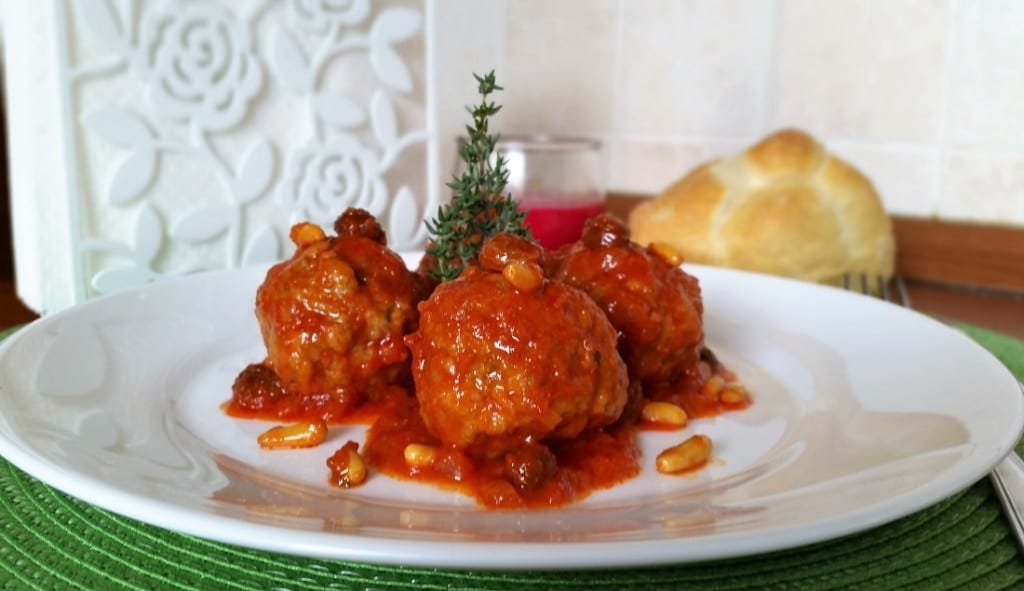Polpetta is “meatball” for Italians. This Sicilian rendition is packed with flavors and exotic aromas reminiscing of the Arab invasion.
Buongiorno amici:
Deliciously soft and inviting, the polpette from Palermo is a homemade dish popular enough that, despite time, will never go out of fashion. The ingredients that make them genuinely fantastic are the milk and bread crumb, which provides that unmistakable softness that characterizes them. Also, the pine nuts and raisins make them tempting because of their aromaticity. Preparing them is simple, undoubtedly laborious, but the result will pay off for the invested time. Let’s get our ingredients and make the polpette following the recipe step by step.
Ingredients for four people
10 ounces of lean ground beef (chuck meat)
10 ounces of fresh ground pork
1/2 cup of freshly grated Ragusan caciocavallo cheese
One cup of dry bread crumb, without seasonings
1/4 of a cup of whole milk + extra if necessary
A pinch of marine salt to choice
A bit of freshly ground black pepper to choice
Three tablespoons of parsley, minced
Eight leaves of fresh basil, thorn by hand
One large clove of garlic, minced
One medium-size white skin onion, minced
Three ounces of tomato paste
Vegetable oil for frying
Three tablespoons of extra virgin olive oil for the sauce base
One tablespoon of fresh thyme, minced
1/2 cup of water, or broths for diluting the tomato paste + extra if needed
Three large whole eggs
Three tablespoons of raisins
Two tablespoons of pine nuts
Procedure
In a small bowl, cover the bread crumb with enough milk and a dash of salt to obtain a semi-soft mass. It should resemble the texture of the ground meat you are using. Squeeze some of the milk from the bread but not excessively, and place it in a large bowl to which you will add the ground beef and pork. Mix the ingredients well and sprinkle with the Ragusano Caciocavallo cheese.
It is now the time to incorporate the parsley, garlic, and a generous amount of freshly ground black pepper. Add the whole eggs and continue the mixing process by hand until you achieve a soft, compact, and homogeneous mixture.
Once the mixture is ready and to your satisfaction, proceed to divide into two ounces balls, using a large spoon, or better yet, an ice cream scoop, which will give you more precision and consistency. Roll the polpette in flour and fry them in a medium-size pan with about 1 cup of vegetable oil. Move the polpette around the oil to achieve a consistent color all around. Drain on absorbent kitchen paper.
At this point, the outside of your polpette looks nice, but the inside remains raw.
There is no panicking because they will cook throughout in the sauce that you will make, beginning by sauteeing the onion in olive oil, using a medium-size skillet, large enough to accommodate the polpette flat. Once the onion is glossy in color, add fresh thyme, and continue the cooking process for about 10 minutes on a gentle heat. The idea is to remove the sugars present in the onion, enhance the flavors, and extract vital vitamins and fibers from the thyme.
Spoon the tomato paste into the onion-thyme mixture, and dilute with water or a broth of choice. (chicken, vegetable, or beef). Adjust the flavor of the sauce with a pinch of salt.
It is now the time to shred fresh basil and continue to cook for 5 minutes. Neatly position the polpette in the skillet, sprinkle the pine nuts and the raisins, and with a spoon, baste the polpette with the sauce. You can cover the skillet with a lid or leave it uncovered. As the sauce cooks down, it will thicken considerably. You may need to add broth along the way to ensure that the inside of the polpette cooks thoroughly. Once the sauce appears thick and luscious, the polpette alla Palermitana is finished and ready to serve hot.
Suggestions
1) Let the meatballs drain on absorbent paper to remove most of the excess frying oil.
2) To give a more robust taste to the raisins, leave them to soak for an hour in a glass of Marsala wine.
3) For a vegetarian option, use the cooked inside eggplant, following similar steps as you would with meat.
{Polpette alla Palermitana, Image Attribution Ricette.it}
Thanks for reading. Eat safe! Ciao Chef W
Download Chef Walters E-Books
Please tune in to our latest Flavors + Knowledge Podcast
Subscribe to the Italian version SAPERE + SAPORI
Subscribe to News you can eat 24 Video-Cast on YouTube
Support Chef Walters Children’s Diabetes Foundation
For recipes, visit the chef blog.














